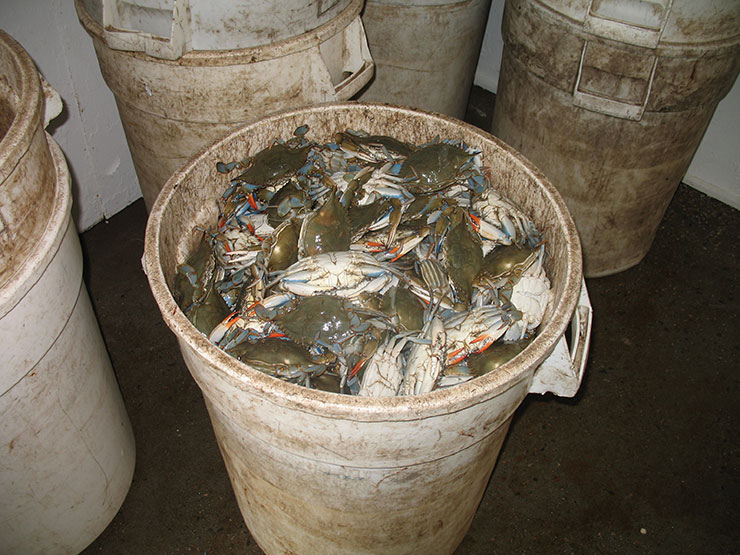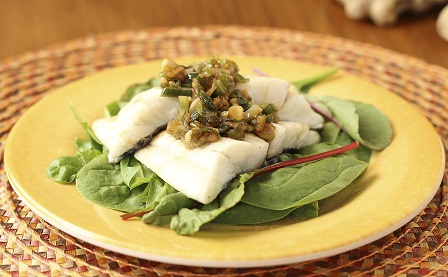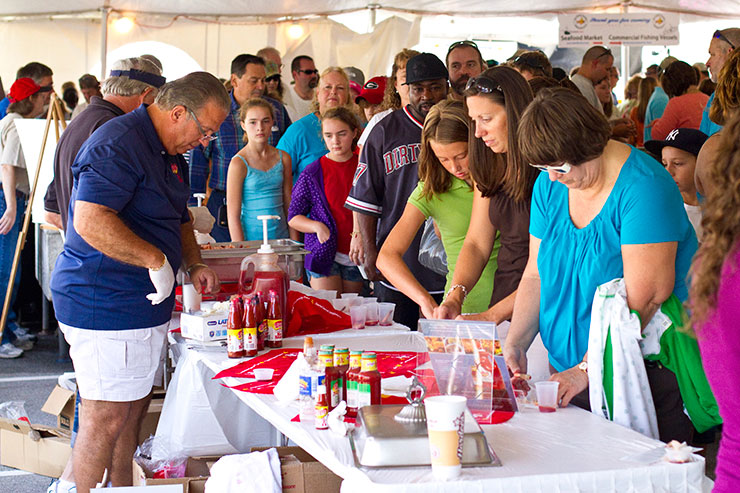Tar Heel Blue Crabs: Still the State’s Most Valuable Seafood

What happens to blue crabs when they are landed by North Carolina crabbers? Where are they processed? Where do they go? Jerry Allegood traces the flow of this crustacean — hard, soft and picked.
It’s a blazing hot summer morning with a steamy haze shrouding the waterfront at Carolina Seafood Co. near Aurora, but it’s cool and comfortable inside the crab-picking room where Flordia Cooper and several other women sit at tables, methodically picking meat from piles of cooked blue crabs.
Cooper takes a crab — its blue shell turned pink by an overnight steam bath — cracks it open and nimbly scoops out small chunks of moist white meat that she drops into a plastic container. At age 71, her fingers move like a phone-texting teen. She has a reputation for picking clean meat without bits of shell. Over and over she repeats the process. Bit by bit, pieces add up to pounds.
“I love it,” she says of the work, which she has done for about 30 years. “It’s not hard. It’s just making the pounds.”
Hand picking crab is a longtime tradition on the North Carolina coast, where the blue crab industry is a mainstay of commercial fishing and the state’s most valuable fishery.

Overall, fishermen last year caught 30.7 million pounds of blue crabs, a 2 percent increase over 2009, according to the N.C. Division of Marine Fisheries. The harvest had a dockside value of $26.5 million.
That broke down to about 29.8 million pounds of hard blue crabs, worth $23.8 million, that was processed into crabmeat or sold live in a so-called basket market popular in northern states. The crab harvest also included 320,472 pounds of soft crabs and 568,265 pounds of peeler crabs that were caught when molting and held for the soft-shell market.
“The blue crab fishery is important to North Carolina. It is the state’s number one fishery based on pounds landed, revenue and number of jobs it provides,” says Marc Turano, North Carolina Sea Grant blue crab specialist. “Despite fluctuations in crab pricing, the industry has a bright future because of the demand and access to the fishery — both fishing grounds and gear needed.”
Turano, also the coordinator of the Sea Grant-administered Blue Crab and Shellfish Research Program, explains that the crab pot, the dominant fishing gear used to harvest blue crab, is a benign fishing gear. Therefore, commercial crabbing has a lower impact on other species in the same environment.
INDUSTRY WOES
Although the crab industry is economically important, it’s a shell of what it used to be.
In the 1990s, annual crab harvests topped 40 million pounds, with a whopping 65.7 million pounds landed in 1996. Like the seafood industry as a whole, the crab industry has declined likey due to a number of factors, including heavy fishing pressure, storms that harmed habitat, rising operating costs and competition from less expensive imported seafood. The industry also faced a drastic decline in dealers and processors.
In 2007, An Inventory of North Carolina Fish Houses noted “catastrophic declines” in the blue crab industry that was undercut by imported crabmeat. The study, funded by Sea Grant, found that the number of certified crab-picking houses in North Carolina had dropped from 45 in 1982 to 13 in 2006. Currently there are 11 crab-processing facilities, according to the DMF.

In addition to competition from imports, the state’s Fisheries Management Plan for Blue Crab blames the loss of processing plants on a lack of a steady supply of blue crabs from local fishermen due to an apparent shift to the live basket market, as well as reduced overall landings in some years.
Other factors include a large percentage of North Carolina crabs being shipped out of state for processing, more stringent federal regulations for seafood handling and higher labor costs.
Barbara J. Garrity-Blake, co-author of the 2007 study with Sea Grant’s Barry Nash, says the loss of picking houses means fishermen can’t sell all their crabs when there is a good season. Garrity-Blake and Nash are now working to update the 2007 survey.
Crabbers benefited from the emergence of the market for live crabs shipped to the north, particularly in the Baltimore and Washington, D.C., areas. But the basket market, so named because the crabs are typically shipped in wooden boxes or baskets, fluctuates and faces competition from crabs caught in the Chesapeake Bay area.
Garrity-Blake, a cultural anthropologist who has written extensively about the state’s fishing industry, says northerners often do not know the crabs they are eating come from North Carolina.
“It just kills me that they get a big pile of crabs and think they are eating Maryland crabs,” she says.
Crab lovers often pay top dollar for hard crabs. For example, Harbor House Crabs, a Pennsylvania company that advertises on the Internet, offers a dozen of the largest crabs, heavyweights larger than 7 inches, for as much as $95. Jumbo crabs, which measure 6.5 to 7 inches, sell for $80 a dozen. A bushel — about five to seven dozen — of small crabs, those from 5 to 5.5 inches, sells for $160. And that’s before shipping and handling.
There is no basket market for crabs in North Carolina, a void that puzzles researchers and those in the industry. “I think that’s an untapped potential,” says Garrity-Blake.
FISHING METHODS
The scrappy little critter with the scientific name Callinectes sapidus — that translates to “beautiful swimmer”— is harvested all year in 28 bodies of water in North Carolina. However, most crabs are caught from May to October in Pamlico and Albemarle sounds.
Regardless of the ultimate destination — processed crabmeat, live crab or soft shell — the route to market usually begins when a hungry crab enters a crab pot, a wire trap that is baited and left in the water. Crab pots, developed in the Chesapeake Bay area, came to North Carolina waters in the 1950s and now account for about 95 percent of the state’s crab landings, with the remainder caught in trawls or as bycatch. As many as 800,000 crab pots are used in the state each year.
Fishermen typically set hundreds of pots, each marked with a small buoy. They maneuver a boat along the line of buoys, pulling up pots, dumping the crabs into wooden baskets and rebaiting the pots. The work is tedious, messy and malodorous as muddy pots clump aboard reeking of rotten fish in their bait boxes.
By the time a crabber works a bunch of pots, he often sports telltale muddy stains on his shirtsleeves and stomach. The next stop is a crab house where the catch is weighed and sorted.
Etles Henries Jr. of Beaufort County hit the water about 5:30 a.m. recently to work about 260 pots in the waters around Muddy and South creeks on the Pamlico River. About midday, he returned to the dock at Carolina Seafood with several hundred crabs in wooden boxes covered with burlap to keep them cool.

Henries’ father, Etles Henries Sr., started a crab business in Pamlico County in 1958 and relocated to the Aurora area in 1964. He ran the business on Muddy Creek until 1982, when Etles Henries Jr. took over. He, in turn, passed it to his son, Vann, about two years ago. The company buys crabs regularly from about 20 fishermen in addition to their own catches. Vann Henries says the company has processed about 2 million pounds a year in the past, but last year it was about 600,000 pounds.
“It’s rewarding,” says Vann Henries, who started working in the family business as a teenager. “You bust your tail for six months out of the year, but the rest of the year you get to breathe. About the time you get to where you never want to see another blue crab, the season is over.”
At Carolina Seafood, the fresh-caught crabs are dunked into a vat of icy water before sorting. Vann Henries says the ice bath cools the crabs for shipping and also makes them less aggressive. He estimates that he was pinched “a thousand times a day” before the ice dip method became common. “They were petty lively and they would get you,” he says.
After the ice bath, the box of crabs is dumped on a table where large males, called jimmies, and females, called sooks, are culled out. Crabs must have shells at least 5 inches wide to be legal in North Carolina.
Company employees Deric Saunders and Shaun Nunn judge some by sight and measure others with a handheld board. Male crabs wider than 6 inches, go into one box, males about 5.5 to 6 inches go into another and ungraded females into a third. Thoses boxes are headed to the basket market in Baltimore.
Smaller crabs that do not make the cut go into barrels to be picked for crabmeat.
GETTING STEAMED
In North Carolina, processing means cooking with steam because boiling crab for sale is not allowed. Steve Murphey, environmental health supervisor with DMF, says steaming sterilizes the meat and makes it safer. In addition, steaming extends shelf life for the product from a couple of days to seven to 10 days.
“It’s more than food safety,” he says. “It’s a matter of food quality.”

During the process, whole crabs that have been kept in coolers are placed in a large container that can hold 1,500 to 2,000 pounds. The container functions like a huge pressure cooker and raises the temperature to 240 degrees Fahrenheit. Under state regulations, a crab in the center of the cooker must be at least 235 degrees.
After cooking, the crabs are cooled to prevent the meat from turning sour. Once out of a cooler, a processor has 3.5 hours to pick the crabmeat, pack it and bring it down to 40 F. The cooling is designed to prevent bacterial growth.
The meat may be cooked yet again if it is pasteurized, a process that gives the meat a shelf life of three to six months. The crabmeat is packed in cans, sealed and placed in a tank and cooked at 185 degrees. It then goes into a cooling tank with chlorinated water. Pasteurized meat can be kept even longer if frozen.
Murphey says most crabmeat imported from Mexico, Venezuela and Asia is pasteurized. “The average person doesn’t get to experience really fresh seafood and doesn’t know what it tastes like,” he says.
Crabs that are bound for the basket market are usually kept at about 50 degrees.
At the Aurora plant, Cooper and about 17 other pickers from nearby communities are paid by the pound for the crabmeat marketed under the brand name Pride of Carolina. Initially shipped to Delaware, it then is distributed throughout the country.
Carolina Seafood is an industry anomaly in its use of local residents for crab picking. Many companies rely on foreign workers, usually Hispanic, who are allowed to work in the industry on a temporary basis under a program approved by the U.S. Citizenship and Immigration Services.
SOFT SHELLS
Another longtime crab dealer, Murray Bridges of Dare County, is credited with pioneering the state’s soft crab market. Bridges, who at age 77 still catches crabs, says he worked with Sea Grant more than 30 years ago to develop his family’s business, which is still operating at Colington in Dare County.
Like others who deal with soft-shell crabs, Bridges catches individuals that are about to molt, or shed their shells, or buys the peelers from other fishermen. He holds and monitors the crabs in tanks until they shed, then moves them to coolers and packs them.
Soft-shell crabs are a delicacy that bring North Carolina dealers $12 to $18 a dozen. On the retail level, the crabs sell for $3 or more each, depending on the size. Bridges says he has shipped as many as 3,000 dozen a day during peak times, usually in May. Like other products, the soft-shell crabs are usually shipped to northern markets.
“It’s not as much a market in North Carolina as it is up north,” he says.
However, soft crabs are starting to become more common in the state. Occasionally, they appear on the menu in local restaurants and in catch shares for Community Supported Fisheries groups.
Vann Henries says fishermen and dealers have attempted to develop a basket market for hard crabs in North Carolina, but it hasn’t been feasible. “People in this area just don’t love crabs the way people in the Baltimore area do,” he points out.
Still, Etles Henries Jr. notes that the Tar Heel crabs are widely distributed. The crabs he catches on Thursday would be picked, packed and shipped north on Saturday. “You don’t get much fresher than that.”
This article was published in the Autumn 2011 issue of Coastwatch.
For contact information and reprint requests, visit ncseagrant.ncsu.edu/coastwatch/contact/.


